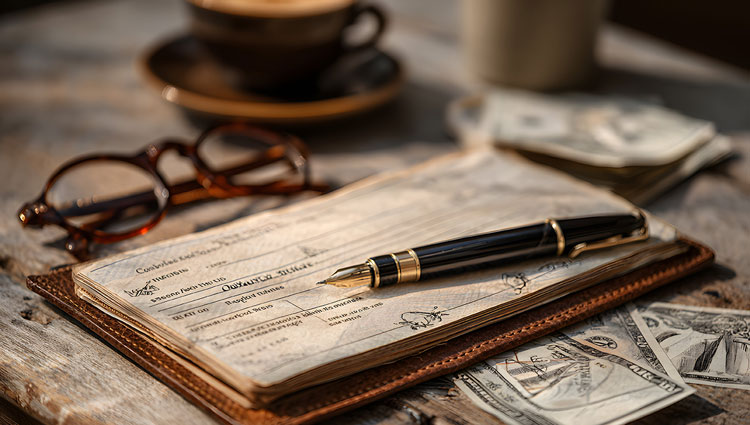Ever wonder how some fundraisers get credited for million-dollar gifts promised with a cocktail napkin scribble, while others are forced to run a gantlet just to get acknowledged for landing a bequest? Or why some fundraisers simply get a pat on the back, while others get hailed as heroes? This article dives into the wild, wacky, and often inconsistent world of fundraiser recognition and compensation. From Ivy League endowments to “olive-stained” pledges, we’re unpacking how organizations credit planned gifts—and whether fundraisers should ever (gasp!) be paid on commission. It’s a mix of ethics, creativity, and eyebrow-raising anecdotes that might just make you question everything you thought you knew about philanthropy. Grab a coffee (or a cocktail napkin) and dive in.
Viken Mikaelian
How Do Organizations Really Count Gifts?
At Plannedgiving.com and Majorgifts.com our inbox is a mixed bag: some emails are as thrilling as checking a grocery list; others make us wonder if kindness is on backorder; and still others kick off marathon coffee-fueled debates that’d put world peace negotiations to shame. Then, every so often, we stumble on a real gem—an email so intriguing that we can’t help but dive in headfirst, no helmet and definitely no second thoughts.
Like this one:
“How do you measure a fundraiser’s success when it comes to planned gifts? A $10M check is easy—boom, it’s in the bank. But a $10M gift in a will? How do you count that? How do you reward the fundraiser? And what happens if it never shows up?”
These are fair questions, and they unravel the moment you tug on the loose thread. Planned gifts are essentially long-distance promises that might not materialize for decades. Some fade away entirely, never making it to the bank. Meanwhile, the fundraiser who made it happen is left wondering if they’ll ever get more than a polite “Good job” and a half-hearted handshake from the nonprofit board’s president.
This curiosity cracked open a door onto the strange, shifting world of fundraiser crediting. Some organizations stick with strict, data-driven metrics, while others—believe it or not—credit a conversation scribbled on a cocktail napkin (we wish we were kidding). In a field supposedly defined by ethics and genuine human connection, how we measure “success” can get weird. Really weird.
The Tussle Between Ethics and Reality
In theory, fundraising is about people and relationships, not commissions or quotas. In reality? It’s about as transparent as a smudged window. Some organizations only reward fundraisers after gifts are fully realized—fair enough. Others cut corners, giving partial credit for vague promises or scaling credit based on the donor’s age (because, apparently, the older the donor, the closer to “the real deal”?).
Consistency? Let’s just say that in the nonprofit galaxy, each planet has its own gravity. Fundraisers doing the same work—building trust, nurturing relationships, guiding donors—might find their efforts valued wildly differently depending on who signs their paycheck.
The Planned Gift Puzzle
Planned gifts add another layer of complexity. A will might promise a multi-million dollar donation, but should the fundraiser count that right away? Some organizations say, “Sure, if the donor is over 75 and provides ironclad documentation.” Others treat a heartfelt promise on the back of a coffee-stained receipt like it’s money in the bank. And then there are those that refuse to acknowledge anything until the gift is actually realized, no matter how sincere the donor’s pledge might have been.
Picture a dedicated fundraiser who spends years nurturing a relationship: calling on birthdays, sending handwritten notes, visiting when times are tough. After all that human effort, if the gift isn’t instantaneous, the acknowledgment might be minimal. It’s a bit like finally finishing a marathon and hearing, “Good job, we’ll tell you your time… maybe in a decade or two.”
Different Worlds, Same Uncertainty
At well-established universities and big institutions, the rules are often strict and money talks loudly. If the funds aren’t physically there, it’s a no-go for credit. Smaller organizations or those under pressure to meet ambitious campaign goals can be more, let’s say, flexible. They might do figurative cartwheels for a promise scrawled on a napkin—because when you’re struggling to make ends meet, even the scent of future cash can feel comforting.
One hospital confided: “If our board chair scribbles a $1M pledge on the back of a dog-eared menu, we’ll celebrate like it’s New Year’s Eve. Some unknown prospect makes a similar promise? Eh, maybe we’ll file it under ‘Nice Thought’ and move on.”
Rethinking Rewards
Then there’s that awkward elephant in the room: Should we offer bonuses to fundraisers landing massive planned gifts? Suggesting anything that sounds like “commission” can ignite heated debate. But could a tiny, ethically acceptable incentive encourage these frontline relationship-builders, giving them more than just a pat on the back?
On the other hand, would rewarding big planned gifts overshadow the importance of smaller, more immediate contributions, or put undue pressure on donors and fundraisers alike? The nonprofit world is all about balance—finding that sweet spot between fair recognition and not accidentally turning generosity into a high-stakes hustle.
The Need for Clearer Guidelines
These strange, shifting norms highlight a bigger gap. Fundraisers are the connectors—the people who guide generous souls toward making the world a better place. They deserve clear, fair, and consistent standards for how their efforts are recognized. They deserve something more human than “Just wait a few decades and see.”
And if all else fails, maybe we really should embrace the cocktail napkin method. After all, nothing says “I value your future generosity” like awkwardly scrawled promises, a wink, and maybe a half-eaten olive for good measure.
In the end, let’s remember that behind every gift, every donor, and every fundraiser is a human being—someone who has invested trust, time, and heart into making the world a better place. They deserve standards that truly honor their contributions, not just a formal acknowledgment. They deserve genuine, heartfelt recognition. And yes, it should be more than just a “Thank You” card.
Perhaps You Could Have Chosen a Better Headline
We had a blast writing this article, but the hardest part? Picking a title. After some spirited debate here were all the contenders. What’s your favorite?
- What’s in a Gift? The Wild, Wacky World of Crediting Fundraisers
- The Fundraiser’s Dilemma: Who Gets the Credit and Who Gets the Pat on the Back?
- From Cocktail Napkins to Millions: The Strange Art of Crediting Fundraisers
- Show Me the Credit! The Curious World of Fundraiser Recognition
- Pat on the Back or Paycheck? The Wild Ride of Fundraiser Rewards
- Million-Dollar Gifts, Zero-Dollar Bonuses: Fundraising’s Great Mystery
- Big Gifts, Tiny Bonuses: The Fundraiser’s Paradox
- Million Dollar Gifts, Thank You Card Bonuses
- Commissioned Donations






This article perfectly captures the humor, frustration, and ethical challenges that come with crediting fundraisers for planned gifts. The anecdotes had me laughing (cocktail napkins and olives, really?), but the underlying message is clear: we need better standards and fairer recognition for fundraisers who work tirelessly to bridge donor intent with impactful giving. Maybe it’s time for the industry to get creative—not just in how gifts are counted, but in how we acknowledge the people making them happen. Cheers to the unsung heroes of philanthropy—and their next million-dollar napkin!
In my experience, the smart way to handle this is:
– If the fundraiser’s only job is planned giving, then you set a goal for the total amount of pledged gifts and 100% of the pledged gifts count towards the goal
– If the fundraiser is a major gift officer who occasionally also solicits (or receives without soliciting) planned gifts, then you discount the pledge by a certain amount to arrive at a credit. For example, you may say that all planned gifts are discounted by 60% and the remainder is credited to the fundraiser’s total (thus, a $1 million planned gift pledge becomes a $600k credit for the MGO). Some organizations arrive at this discount amount by looking at the actual gift fulfillment rate for planned gifts at their organization, others simply choose a number.
Either way, your team should celebrate staff members who bring in planned gift pledges!
Thank you for sharing this article! As a fundraiser, the article raised many issues regarding the appropriate credit for deferred gifts, valuation of the deferred gift, as well as the sore issue of compensation. The appropriate credit (e.g., 100%) for a fundraiser’s effort is usually determined by the time and effort (e.g., the solicitation and closing) to secure a deferred gift. Also, for those organizations that follow CASE reporting standards, valuation of the deferred gift is easily determined. The issue of compensation is the elephant in the room. Most fundraisers and organizations that follow the AFP ethical rules understand and expect fair and equitable compensation. However, compensation based on a percentage of funds raised violates the AFP Code of Ethical Conduct. Despite state and local equal pay laws, the real change in fair and equitable compensation will probably come when more planned giving officers are promoted into senior advancement positions with hiring authority.